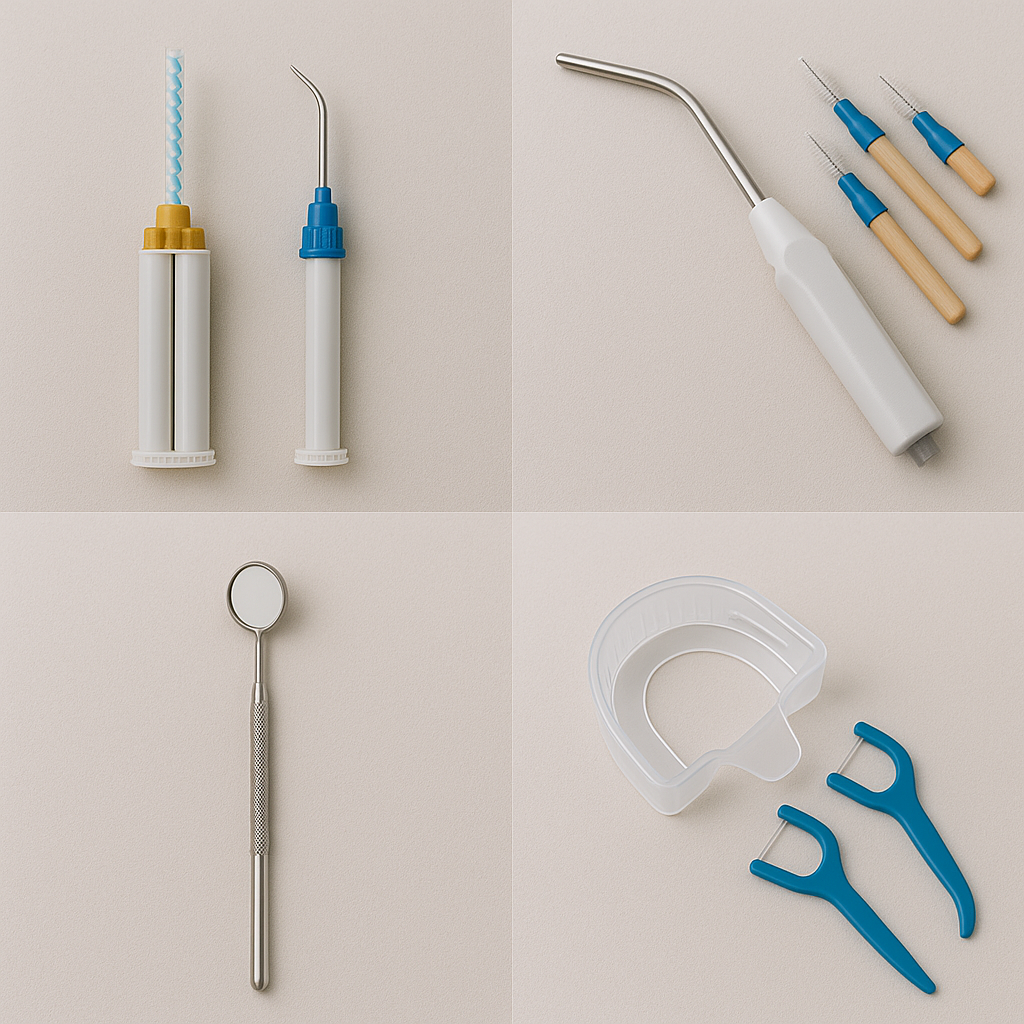Whether you’re a patient trying to flush your sockets after an extraction or a professional looking for guidance on applying anesthesia or some other solution in your patient’s mouth, understanding proper dental syringe use is of the utmost importance.
Missteps carry the risk of cross-contamination, inaccurate dosage, and of course, patient discomfort. Don’t worry, we’ll walk you through how to use dental syringe below to leave you feeling confident no matter the specific use case.
The first step, though, is to stock up on your essentials here at My DDS Supply, your trusted dental syringe supplier. You can source all your dental supplies in one place and ensure you’re setting your practice up for success.
Shop today and experience the difference our instruments and world-class service can make!
Understanding Dental Syringes
There are countless tools that keep your practice running on a daily basis, and dental syringes are among the most essential.
They’re used for everything from administering anesthesia, irrigating canals, and applying composite materials. Having a grasp on the different styles is essential for any practicing dentist. Each serves a distinct purpose.
For example, aspirating syringes are used for administering local anesthesia. They’re designed with a mechanism that allows the dentist to draw back, ensuring the needle is not in a blood vessel before injecting an anesthetic. This prevents accidental intravascular injections.
On the other hand, there are irrigation syringes used for rinsing and cleaning dental areas during procedures. They often come with curved or blunt tips for precise application of fluids without causing tissue damage.
Across all syringes, you’ll find a few key components. These include:
- Barrel: The cylindrical part of the syringe that holds the liquid to be injected. It’s typically made of clear plastic or glass so the dentist can see the contents and measure the dosage accurately. It’s marked with gradations for precise measurement.
- Plunger: Fits snugly inside the barrel and is used to draw up and expel the liquid. When the plunger is pulled back, it creates a vacuum that draws the liquid into the barrel. When pushed forward, it forces the liquid out through the needle.
- Needle: A thin, hollow tube attached to the end of the barrel through which the liquid is injected into the patient. Needles come in various lengths and gauges depending on the procedure and the area of the mouth being treated. The sharpness and design of the needle tip can influence patient comfort.
- Hub: The part of the syringe that connects the needle to the barrel. It’s usually color-coded to indicate the gauge of the needle so the dentist can identify the appropriate needle size quickly. The hub allows for secure attachment of the needle to the syringe.
Each component of the dental syringe plays a vital role in the effectiveness and safety of the injection process. That being said, these instruments are fairly simple and straightforward. Yet, proper dental syringe use cannot be overlooked. Here’s why…
The Importance of Proper Dental Syringe Use
The margin for error is slim to none in your dental practice, which is why knowing how to use dental syringe correctly is so important. There are specific reasons you need to be meticulous in your dental syringe use techniques.
Preventing Cross-Contamination
Dental syringes, if not used properly, can become vectors for the transmission of pathogens. You must ensure each syringe is only used once, and proper disposal is just as important as actually using the syringe.
Dentists also need to maintain sterility during the handling and administration of injections, from wearing dental gloves to avoiding syringe contact with non-sterile surfaces.
Ensuring Accurate Dosage and Delivery
Miscalculations or improper administration can lead to inadequate anesthesia, prolonged procedures, or adverse reactions.
Much of this can be avoided by simply using high-quality syringes with clear, accurate gradations for precise measurement of the required dosage. As we said earlier, using an aspirating syringe helps confirm that the needle is not in a blood vessel for anesthetic injections.
Meanwhile, maintaining consistent pressure on the plunger during injection ensures a smooth and controlled delivery of the medication, minimizing discomfort and ensuring effectiveness.
Enhancing Patient Comfort and Safety
The goal is always to ensure the most comfortable experience for your patients, especially given the anxiety so many face when coming to sit in your chair.
The needles and syringes you use can make a big difference here. Sharp, high-quality needles paired with proper injection techniques reduces the pain associated with injections. Similarly, using the correct gauge and length of needle for the procedure ensures minimal tissue trauma.
Understanding how to use dental syringe can help you avoid unfavorable outcomes such as tissue necrosis, hematoma formation, or infection. So, let’s get into proper dental syringe use below, starting with how to use dental irrigation syringe since it’s far more straightforward.
How to Use Dental Irrigation Syringe
Whether you’re trying to irrigate a patient’s mouth during a procedure or you’re trying to send your patients home with instructions to care for their sockets after an extraction, here’s how these syringes work:
- Gathering Supplies: Start by assembling all necessary supplies, including the irrigation syringe, irrigation solution (such as saline or an antiseptic rinse), and a suction device.
- Filling the Syringe: The irrigation solution should be at room temperature to avoid discomfort.
- Positioning: Position the syringe close to the area that needs rinsing. Ensure that the patient's head is properly tilted to allow for fluid drainage.
- Irrigating the Area: Gently depress the plunger to release a steady stream of solution. Use a suction device to remove excess fluid and debris from the mouth.
- Repetition: Repeat the process as needed to ensure the area is thoroughly cleaned, particularly during procedures like root canals or extractions.
- Post-Irrigation Care: After irrigation, instruct the patient to rinse their mouth with water or a prescribed mouth rinse.
Fairly straightforward, right? This simple tactic can have a profound effect on the healing process, though, ensuring favorable outcomes. That being said, let’s get into how to use dental syringe for injections, which is a bit more complex.
How to Use Dental Syringe for Injections
Administering injections with a dental syringe requires more precision and care to prioritize patient safety and comfort.
Selecting the Appropriate Syringe and Needle
You’ll use an aspirating syringe for administering local anesthetics, as these allow for aspiration to check if the needle is in a blood vessel.
Similarly, choose the needle gauge and length based on the injection site and patient needs. Thinner needles (higher gauge) cause less discomfort, while longer needles are necessary for deeper injections.
Drawing the Solution
Make sure the vial containing the solution is sterile. If necessary, clean the rubber stopper with an alcohol swab.
Then, insert the needle into the vial’s stopper and pull back the plunger to draw the required amount of solution into the syringe. Remove any air bubbles by gently tapping the syringe and pushing the plunger slightly.
Administering the Injection
Before actually injecting the solution into the patient’s oral cavity, take a moment to explain what you’re doing to them to alleviate anxiety. Make sure they’re positioned comfortably. Then follow these steps:
- Injection Site Preparation: Clean the injection site with an antiseptic swab to reduce the risk of infection.
- Injection Technique: Hold the syringe with a firm grip and insert the needle into the tissue at the appropriate angle and depth. For intramuscular injections, a 90-degree angle is typically used. For subcutaneous injections, a 45-degree angle may be appropriate.
- Aspiration: Pull back the plunger slightly to check for blood, which indicates that the needle is in a blood vessel. If blood is aspirated, withdraw the needle and select a new injection site.
- Administering the Solution: Once confirmed that the needle is correctly positioned, slowly depress the plunger to inject the solution. Maintain a steady hand to minimize discomfort.
Post-Injection Procedures
After administering all the solution, gently withdraw the needle from the tissue and immediately dispose of it in a sharps container to prevent needle-stick injuries.
Apply gentle pressure to the injection site with a sterile gauze pad to stop any bleeding. Our dental gauze may be applied if necessary, as it’s considered to be the best gauze for tooth extraction or anything in between.
Monitor the patient for any adverse reactions, such as swelling or allergic responses. Provide aftercare instructions, including what to expect and when to seek medical advice.
Stock Up on Dental Syringes at My DDS Supply Today!
There you have it, how to use dental syringe whether you’re simply trying to irrigate a patient’s mouth or apply anesthesia. The only thing left to do now is stock up on the best selection of syringes at My DDS Supply.
Our selection includes everything from Curved Tip 12cc Monoject 412 Style Dental Oral Irrigation Utility Syringes, ideal for thorough irrigation, to precise 3cc syringes available in 27, 25, and 30 Gauge options, each with color-coded tips for quick and easy identification.
We are dedicated to providing dental professionals with reliable and high-quality tools. Our syringes are available in quantities ranging from 25 to 2000, making it easy to stock up according to the size of your practice.
You can also source all the other essentials here from us while you’re at it, from dental bibs to dental face masks, dental putty, temporary dental cement, dentist needles, dental burs, and more.
With the best quality products at unbeatable prices and world-class customer service along the way, what more could you ask for? Shop today and elevate the standards of care in your practice.
Final Thoughts on How to Use Dental Syringe
Proper use of dental syringes is essential for preventing cross-contamination, ensuring accurate dosage, and enhancing patient comfort. While it’s something every dentist should learn in school, we understand the need for routine refreshers. We hope this guide has left you feeling clear and confident in proper dental syringe use!
Our blog has additional resources on topics such as dental suctioning techniques, how long does dental cement last, how to make dental putty at home, types of dental burs, how strong is dental cement, how to make a temporary crown, and a whole lot more.
Otherwise, the only thing left to do now is source all your supplies here at My DDS Supply, the industry’s trusted choice for high-quality products and unbeatable support. Transform your sourcing for the better today!

